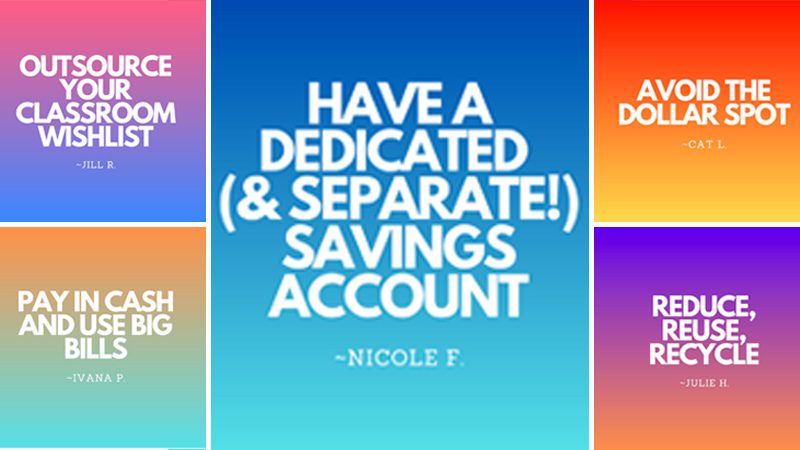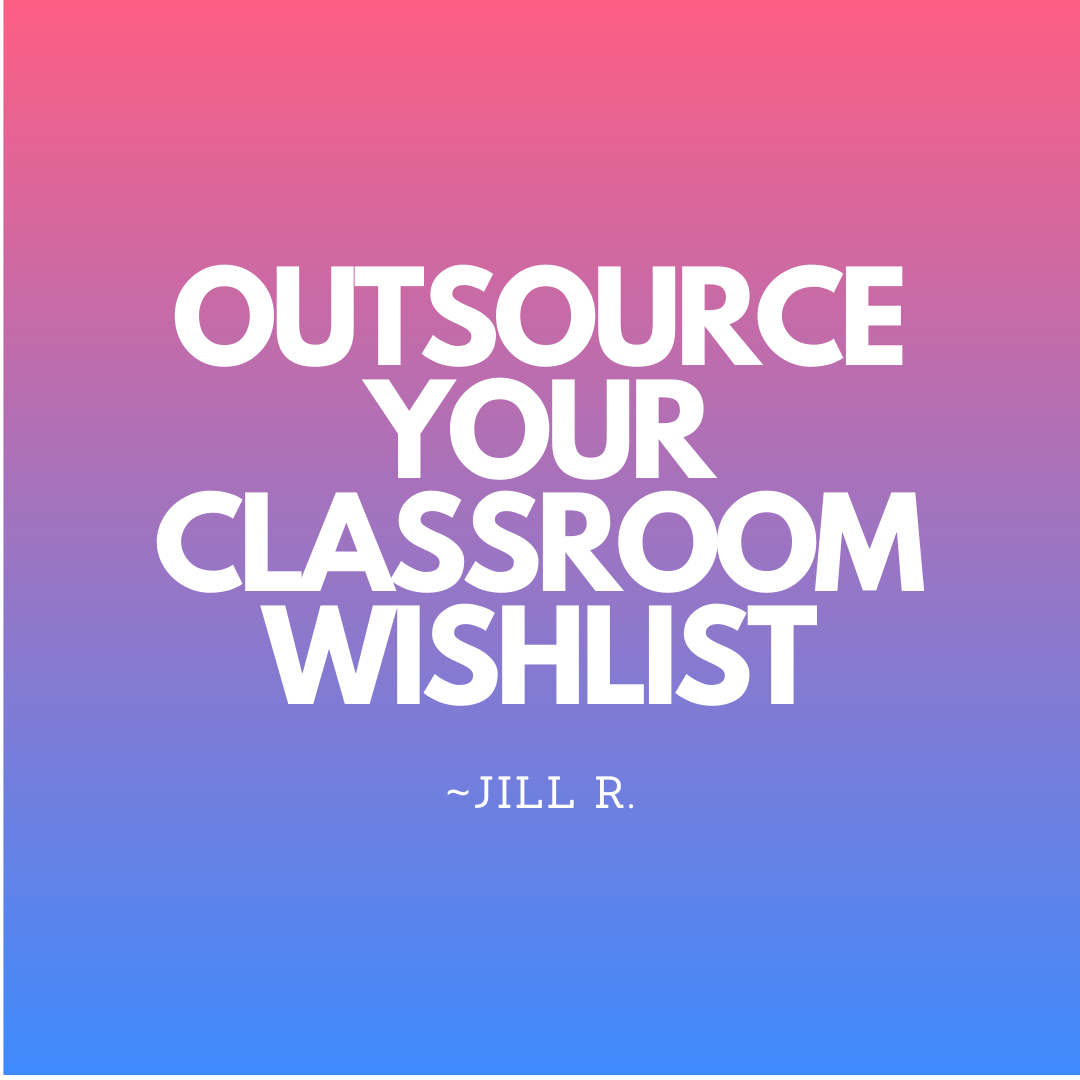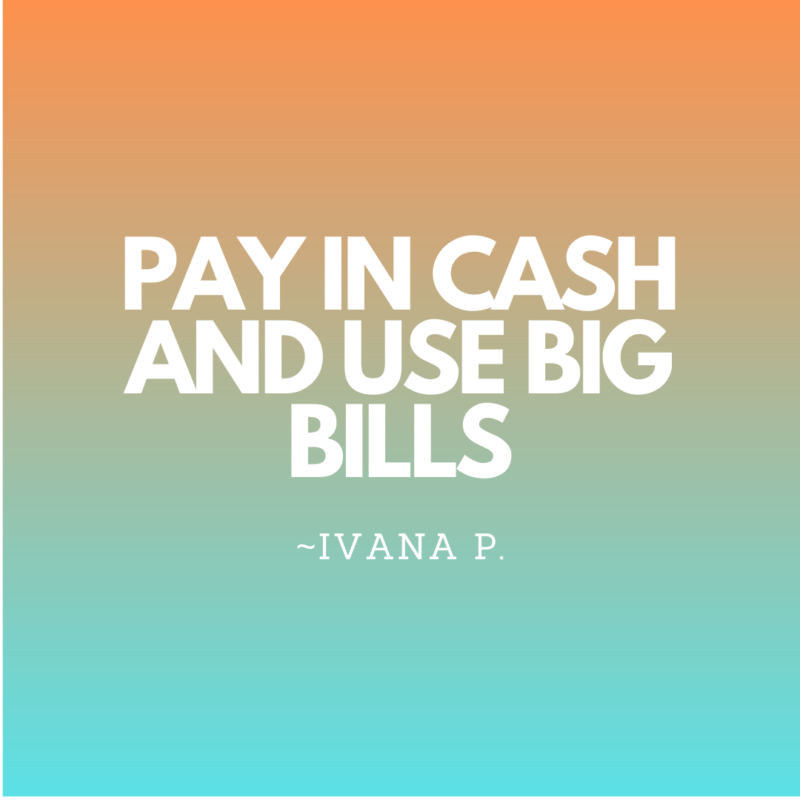The start of a new school year often brings excitement, nerves, preparation, planning, and with all that, additional expenses. With that in mind, we’ve asked teachers across the country for their best money-saving hacks to help put a bit more moolah in your pocket.
1.
Jill R. says she saves money by asking her friends, family, and community to help supply her classroom. Rather than spend hundreds of your own dollars outfitting your room, share your Amazon wishlist with your family and friends. Many of them will be delighted to help you by buying those birthday pencils for your students! Try out DonorsChoose for bigger projects.
2.

Chris E. tells WeAreTeachers that while uniquely-themed classrooms often look amazing, they’re also expensive for the teacher. Save yourself a ton of money (and time!) by choosing a colorful but simple theme that will be inviting and appealing for multiple years. Alternatively, start with an empty classroom!
3.

Students are notoriously careless when it comes to leaving supplies behind at the end of the school year. Julie H. saves a fortune on purchasing pencils, notebooks, backpacks, and other school supplies for her classroom by hanging around when her school custodians clear out the school lockers before summer vacation begins and picking up all the slightly used but still worthwhile supplies students have left behind.
4.

The pandemic kept all of us in our homes searching for things to do. For many of us, that meant signing up for a few new streaming services, monthly subscription boxes, etc. Studies have placed the percentage of people who underestimate how much they spend on these services at 84%! Taking a few minutes to make sure you still utilize all the services you’re paying for might pay off big time!
5.

A quick internet search will reveal hundreds of ideas from individuals who have found ways to make saving fun. One blogger even claimed to have saved over $40,000 by paying for everyday items like groceries and coffee with cash and saving just the five-dollar bills.
6.
Target employs people specifically to make the Dollar Spot as enticing as possible. We know that we’ll find something that we want in there, but we also know it’s almost definitely not worth the $1-$15 bucks we’ll end up spending. Save your wallet by skipping right past it as you do your necessary shopping.
7.

The number of financial podcasts out there is staggering, but many of them are actually quite entertaining. Look for one geared toward beginners and spend a few minutes of your morning commute learning how to improve your financial health. The Fairer Cents and You Need a Budget are two great options for those looking for a place to begin.
8.

Make the most of your paycheck, and pay yourself first. As the new school year begins, some teachers will go up a step in their district pay scale or receive a pay increase of some sort. If you are one of these lucky few, choose to have the increase placed directly into savings now before you get used to seeing it in your paycheck.
9.
Those small, “inconsequential” purchases really add up fast! Trick yourself into slowing down and considering if you really need an item by doing most of your buying with cash. Make sure your wallet only has $20s or $50s, and you’ll find yourself asking, “Do I really want to break a $50 for that [fill in the blank]?”
10.

If the thought of carrying a bunch of large bills around in your wallet makes you nervous, trying saving your change instead. Clean out a pretty vase that doesn’t get enough use and put it someplace you’ll pass by each day. Get everyone in the family involved in putting all their loose change into the container at the end of every day and watch it fill up.
11.

The urge to buy that shiny, new whatever can be unbelievably strong in the moment, but often whatever we were planning on buying can seem far less necessary after we leave the store. Use Google Keep or a note on your phone to keep track of the items you successfully walked away from. Whenever you feel like you have to have that new thing, bring out your list to remind you of just how unimportant it will feel later on. For extra motivation, add the price of each item to your list so you can see just how much you’ve saved by walking away.
12.

Many teachers have realized that decorating their classrooms with their own money drains their bank account and just isn’t worth it. Mia C. states, “My paycheck is not used to fund my program at school.” This is great money-saving advice! But if you’re someone who still loves making your classroom your own and you’re willing to put in your own money to do so, become a bit savvier with where you do your shopping. Amber C. says, “I do spend my own money to make my classroom ‘mine.’” But she does it wisely by using dollar store wrapping paper as bulletin board background. Other teachers recommend a cheap fabric that doesn’t fade as quickly as expensive bulletin board paper and can be used year after year.
14.

Back-to-school planners and lesson plan books can be beautiful and fancy enough to trick even the most seasoned teacher into thinking, “If I buy this planner, maybe this year I’ll be organized and calm and get all my grading done in a timely fashion.” In reality, however, they rarely pass the test of time. Save the money you would have spent on that shiny, new planner by making your own using a free template from Google or another teacher online. Being able to customize exactly what you need for your classroom will make it far more useful than anything you would have purchased from a store, and if a part of it isn’t working the way you thought it would, you can update it instantly!
15.

A study by Equitable found that educators who work with a financial professional exhibit more effective financial behaviors. So why aren’t more of us doing it? We get it! There are lots of reasons why contacting a financial advisor can feel daunting. Do I even make enough? I can barely save enough for my daily living expenses! I’m embarrassed about our debt. I don’t understand any of that stuff. But financial advisors are experts on all of these topics, and they’ve seen it all. A good advisor will sit down with you for no charge and discuss the ways you can begin to invest in your future. You do not need to be “rich” to speak to someone about your finances, and the sooner you start, the better!
16.

There have been very few positives that have come out of the COVID-19 quarantine, but one of them is definitely the increased options we now have regarding grocery shopping. Many stores now offer the ability to place your order online and pick your groceries up at a pre-selected time. Making your selections without the hassle of walking down each aisle is delightful, but being able to shop from home when you’re not nearly as likely to make those expensive impulse purchases can be incredibly beneficial to your wallet.
17.
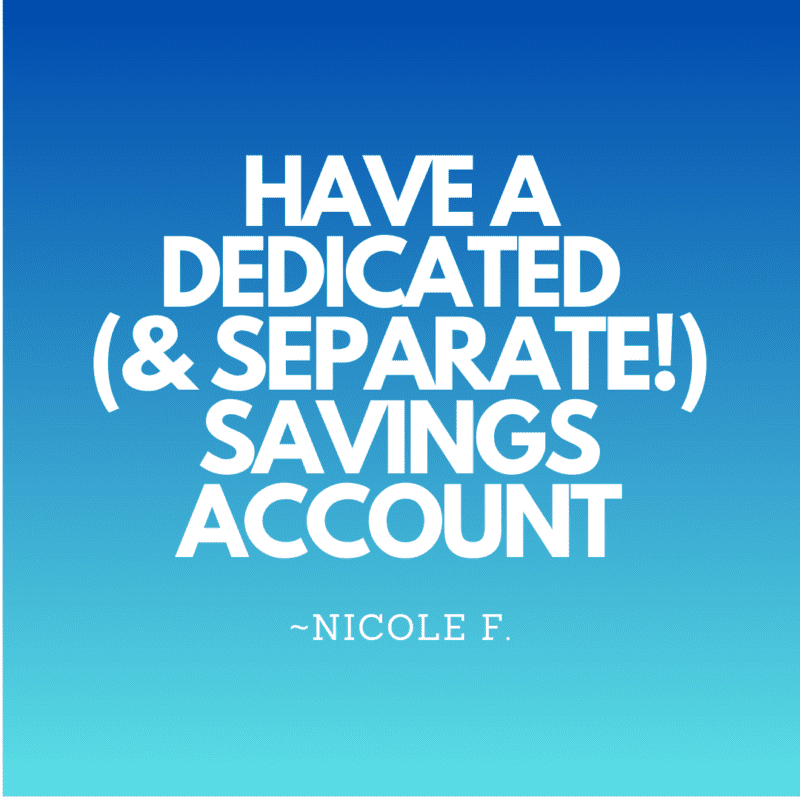
While some people can keep all of their money in one account and not be tempted to overspend, most of us would benefit from having a dedicated savings account that we don’t go into unless it’s an absolute emergency. Automate it, so you put a set amount into this account each month and leave it alone. Your savings will grow without you even needing to worry about it.
18.
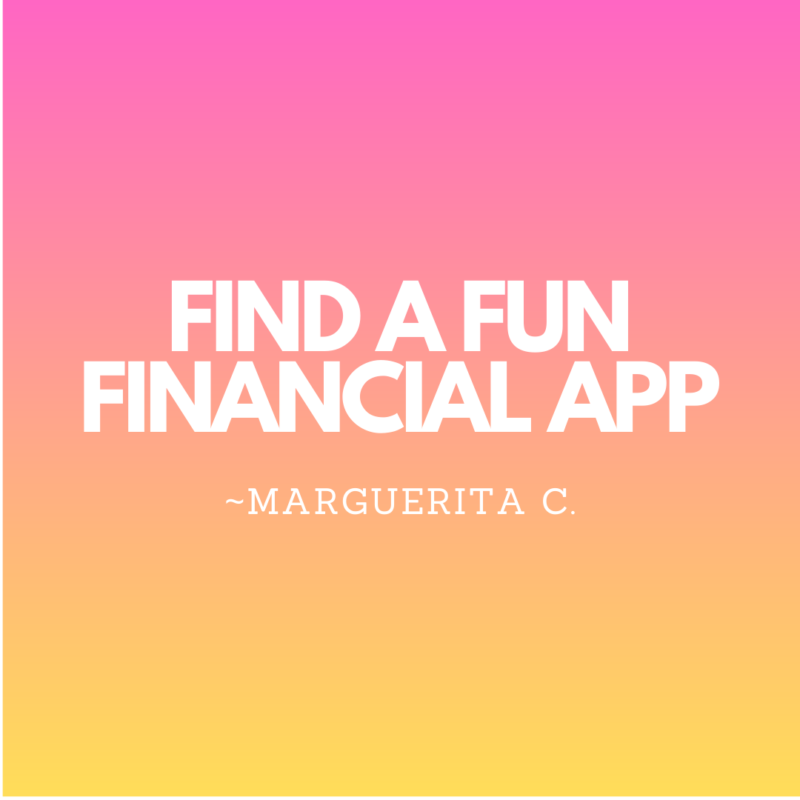
Hundreds of money-saving apps exist for the sole purpose of helping us save. Spend some time browsing the app store to see if any of them might work for you. Some apps take tiny amounts of money out of your checking or savings account each week and invest it for you; others round off each of your purchases and deposit that change into your savings account, and some even give you daily or weekly money-saving challenges. Find one that makes saving money fun for you, and watch the money pile up!
19.

Make a deal with a partner or close bestie that you’ll check in with one another before making large purchases (many couples set the amount at $50 or so). Think those cute fall boots are an absolute must? Sometimes having someone remind us of what we are saving for or why we want to save more money is all we need to be able to walk away from an impulse buy.
20.
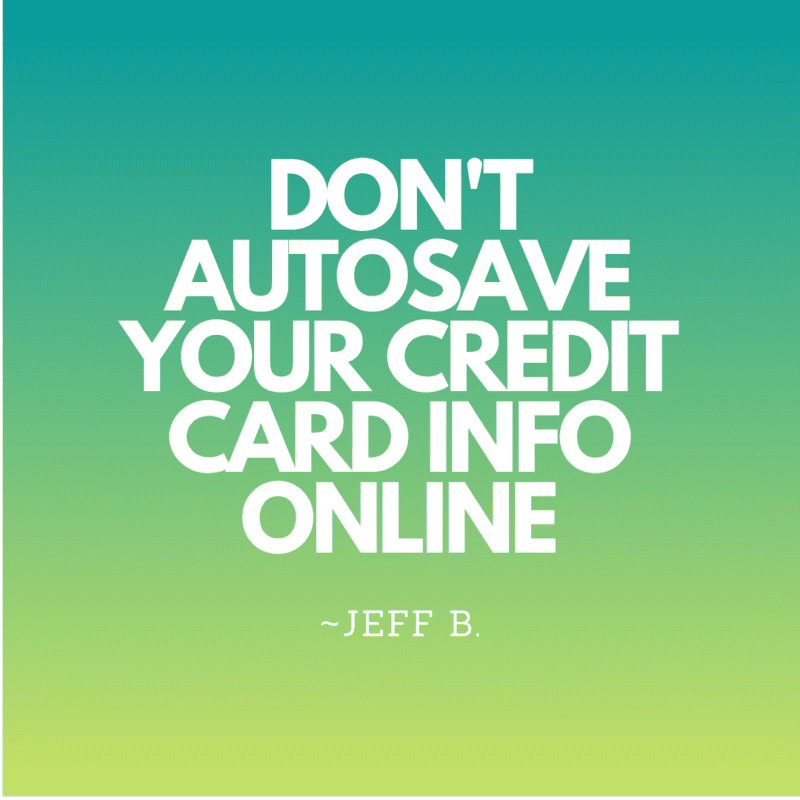
Online stores want to make it as easy as possible for us to spend money at their site, so many of them will “helpfully” offer to save your credit card information for “faster check-out” later on. Just say no! The next time you find yourself with a cart full of things you don’t really need, the time it takes to get out of the comfy chair and find your wallet might be just enough to make you rethink the purchase altogether.
22.

A soda or iced tea will set you back about $3 at many restaurants. While you do get free refills, most of us don’t really drink enough to make that a good deal. Considering that a family of four increases their dinner tab by over $12 just by drinking something other than water, you can see how quickly you can save some money just by sticking with water when you go out.
23.

Sometimes a daily reminder or tip on how to become more financially responsible is just the nudge we need. Instead of following those social media influencers who always seem to be jetting off to some tropical island or wearing the latest fashions, add a few new faces to your social media mix. There are influencers who discuss minimalism, financial responsibility, and savings tips. That way, you’ll be inspired to save for what you really want instead of what some influencer is being sponsored to promote. Check out @clevergirlfinance or @thefinancialdiet on Instagram for a good starting point!
24.

As teachers, we know all about gamification of learning—making things feel like a game automatically increases buy-in and interest. Use those same concepts at home by challenging yourself and your family to one “No Spend Weekend” a month. Come up with activities you can do that cost nothing, see which family member can create the most delicious meals with only items already in your pantry and fridge. The key is not just curbing the expenses also moving that money to where it can serve your future.
25.

Just like we tell our students, if you want to see improvement, you have to put in the practice. Be sure to set specific goals—both short- and long-term—and check how you’re doing on attaining them. If you make a mistake, don’t beat yourself up. It happens to everyone. Use it as an opportunity to check in with an expert to get you back on track, remind yourself of what you really want, and keep moving forward!

